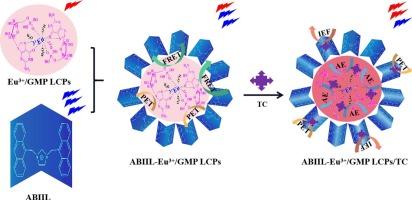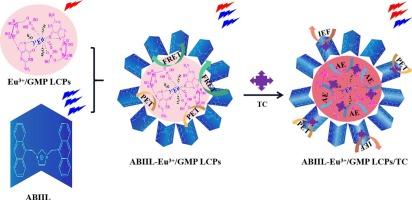A novel reversible-responsive ratiometric fluorometry based on an anthracene-based imidazolium ionic liquid and Eu3+-based lanthanide coordination polymers for selective sensing tetracycline in foods and waters
IF 9.8
1区 农林科学
Q1 CHEMISTRY, APPLIED
引用次数: 0
Abstract
Detecting tetracyclines' (TC) residues is of great significance for evaluating the food and environmental safety. Herein, we pioneered a reversible-responsive ratiometric fluorometry by integrating the red fluorescence of Eu3+/GMP lanthanide coordination polymers (Eu3+/GMP LCPs) with the blue fluorescence of an anthracene-based imidazolium ionic liquid (ABIIL). In the presence of TC, the fluorescence of ABIIL was quenched by TC via the inner-filter effect and photoinduced electron-transfer process, but that of Eu3+/GMP LCPs was enhanced owing to the antenna effect between Eu3+ and TC. Based on the reversible variations of the fluorescence signals, a fluorescent assay based on ABIIL-Eu3+/GMP LCPs was engineered to detect TC with satisfactory sensitivity and selectivity. A good linearity for TC was acquired from 0 to 50 μM with the detection limit of 3.0 nM and the significant color changes. Therefore, the assay was a promising approach for the visual detection of TC in complex media


一种基于蒽基咪唑离子液体和Eu3+基镧系配位聚合物的新型可逆响应比例荧光法,用于选择性检测食物和水中的四环素
四环素类药物残留检测对食品环境安全评价具有重要意义。在此,我们开创了一种可逆响应的比例荧光法,通过将Eu3+/GMP镧系配位聚合物(Eu3+/GMP lcp)的红色荧光与蒽基咪唑离子液体(ABIIL)的蓝色荧光相结合。在TC存在下,ABIIL的荧光通过内滤效应和光致电子转移过程被TC猝灭,而Eu3+/GMP LCPs的荧光由于Eu3+与TC之间的天线效应而增强。基于荧光信号的反向变化,设计了一种基于ABIIL-Eu3+/GMP LCPs的荧光检测方法,以满意的灵敏度和选择性检测TC。TC在0 ~ 50 μM范围内具有良好的线性关系,检出限为3.0 nM,颜色变化明显。因此,该方法是一种很有前途的复杂介质中TC的视觉检测方法
本文章由计算机程序翻译,如有差异,请以英文原文为准。
求助全文
约1分钟内获得全文
求助全文
来源期刊

Food Chemistry
工程技术-食品科技
CiteScore
16.30
自引率
10.20%
发文量
3130
审稿时长
122 days
期刊介绍:
Food Chemistry publishes original research papers dealing with the advancement of the chemistry and biochemistry of foods or the analytical methods/ approach used. All papers should focus on the novelty of the research carried out.
 求助内容:
求助内容: 应助结果提醒方式:
应助结果提醒方式:


